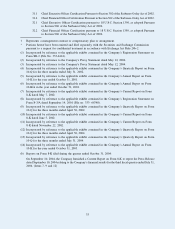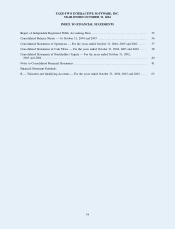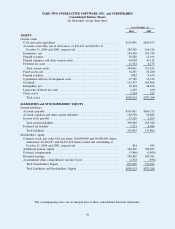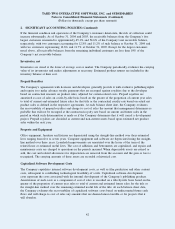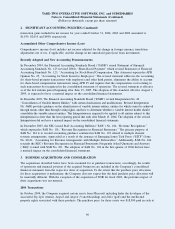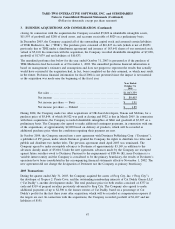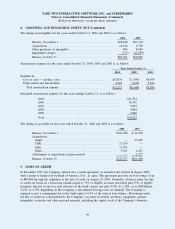2K Sports 2004 Annual Report Download - page 50
Download and view the complete annual report
Please find page 50 of the 2004 2K Sports annual report below. You can navigate through the pages in the report by either clicking on the pages listed below, or by using the keyword search tool below to find specific information within the annual report.
If the financial condition and operations of the Company’s customers deteriorate, the risk of collection could
increase substantially. As of October 31, 2004 and 2003, the receivable balances from the Company’s five
largest customers amounted to approximately 45.1% and 54.6% of the Company’s net receivable balance,
respectively, with two customers accounting for 12.8% and 11.2% of such balance at October 31, 2004 and
with two customers representing 16.6% and 11.7% at October 31, 2003. Except for the largest customers
noted above, all receivable balances from the remaining individual customers are less than 10% of the
Company’s net receivable balance.
Inventories, net
Inventories are stated at the lower of average cost or market. The Company periodically evaluates the carrying
value of its inventories and makes adjustments as necessary. Estimated product returns are included in the
inventory balance at their cost.
Prepaid Royalties
The Company’s agreements with licensors and developers generally provide it with exclusive publishing rights
and require it to make advance royalty payments that are recouped against royalties due to the developer
based on contractual amounts on product sales, adjusted for certain related costs. Prepaid royalties are
amortized as cost of sales on a title-by-title basis based on the greater of the proportion of current year sales
to total of current and estimated future sales for that title or the contractual royalty rate based on actual net
product sales as defined in the respective agreements. At each balance sheet date, the Company evaluates
the recoverability of prepaid royalties and charge to cost of sales the amount that management determines is
probable that will not be recouped at the contractual royalty rate based on current and future sales in the
period in which such determination is made or if the Company determines that it will cancel a development
project. Prepaid royalties are classified as current and non-current assets based upon estimated net product
sales within the next year.
Property and Equipment
Office equipment, furniture and fixtures are depreciated using the straight-line method over their estimated
lives ranging from five to seven years. Computer equipment and software are depreciated using the straight-
line method over three years. Leasehold improvements are amortized over the lesser of the term of the
related lease or estimated useful lives. The cost of additions and betterments are capitalized, and repairs and
maintenance costs are charged to operations in the periods incurred. When depreciable assets are retired or
sold, the cost and related allowances for depreciation are removed from the accounts and the gain or loss is
recognized. The carrying amounts of these assets are recorded at historical cost.
Capitalized Software Development Costs
The Company capitalizes internal software development costs, as well as film production and other content
costs, subsequent to establishing technological feasibility of a title. Capitalized software development
costs represent the costs associated with the internal development of the Company’s publishing products.
Amortization of such costs as a component of cost of sales is recorded on a title-by-title basis based on the
greater of the proportion of current year sales to total of current and estimated future sales for the title or
the straight-line method over the remaining estimated useful life of the title. At each balance sheet date,
the Company evaluates the recoverability of capitalized software costs based on undiscounted future cash
flows and will charge to cost of sales any amounts that are deemed unrecoverable or for projects that it
will abandon.
TAKE-TWO INTERACTIVE SOFTWARE, INC. and SUBSIDIARIES
Notes to Consolidated Financial Statements (Continued)
(Dollars in thousands, except per share amounts)
2. SIGNIFICANT ACCOUNTING POLICIES (Continued)
42



